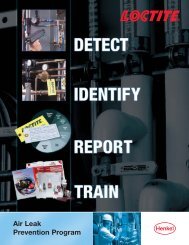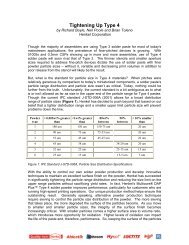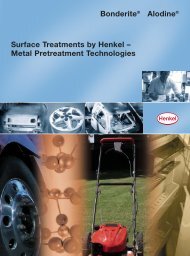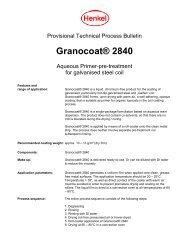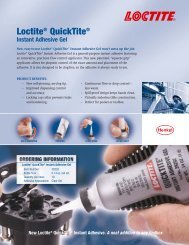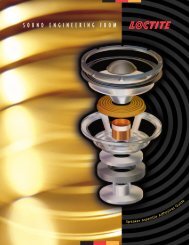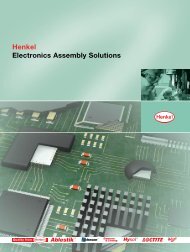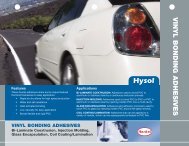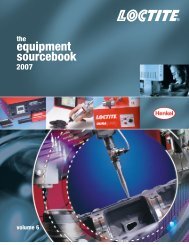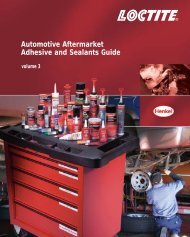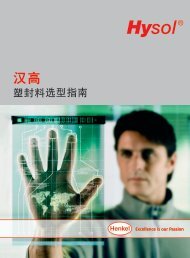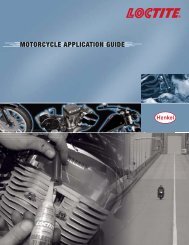Porosity Sealing by Design - Loctite.ph
Porosity Sealing by Design - Loctite.ph
Porosity Sealing by Design - Loctite.ph
- No tags were found...
Create successful ePaper yourself
Turn your PDF publications into a flip-book with our unique Google optimized e-Paper software.
<strong>Porosity</strong> <strong>Sealing</strong> <strong>by</strong> <strong>Design</strong>
1TABLE OF CONTENTSINTRODUCTION . . . . . . . . . . . . . . . . . . . . . . . . . . . . . . . . . . . . . . . . . . . . . . . . . . . . . . . . . . . . . . . . . . . . . . . . . . . . . . . . . . . . 2MODERN POROSITY SEALING FOR THE TWENTY-FIRST CENTURY . . . . . . . . . . . . . . . . . . . . . . . . . . . . . . . . . . . . . . 3• A DESIGNED-IN MANUFACTURING OPERATION• OLDER TECHNOLOGIESCURRENT TECHNOLOGIES . . . . . . . . . . . . . . . . . . . . . . . . . . . . . . . . . . . . . . . . . . . . . . . . . . . . . . . . . . . . . . . . . . . . . . . . . . 4• RESIN IMPREGNATION — HOT WATER CURING• RESIN IMPREGNATION — ANAEROBICLOCTITE ® IMPREGNATION PRODUCTS . . . . . . . . . . . . . . . . . . . . . . . . . . . . . . . . . . . . . . . . . . . . . . . . . . . . . . . . . . . . . . . . 4• HOT WATER CURING• SELF-CURING ANAEROBIC• HOW THEY COMPARE• ANAEROBIC ADVANTAGESELECTION OF LOCTITE ® IMPREGNATION PRODUCTS . . . . . . . . . . . . . . . . . . . . . . . . . . . . . . . . . . . . . . . . . . . . . . . . . 7• LOCTITE ® RESINOL ® 90C (HOT WATER CURING)• LOCTITE ® RESINOL ® 88C (HOT WATER CURING)• LOCTITE ® RESINOL ® 90R (HOT WATER CURING, RECYCLABLE)• LOCTITE ® PMS-50E (ANAEROBIC)• LOCTITE ® RESINOL ® RTC (ANAEROBIC)• LOCTITE ® RESINOL ® AT (ANAEROBIC)• LOCTITE ® PM 5120 (ANAEROBIC)• LOCTITE ® 990 SPRAY SEALANT (ANAEROBIC)• SPECIAL USESVACUUM IMPREGNATION METHODS. . . . . . . . . . . . . . . . . . . . . . . . . . . . . . . . . . . . . . . . . . . . . . . . . . . . . . . . . . . . . . . . . 9• DRY VACUUM/PRESSURE (DVP)• WET VACUUM/PRESSURE (VP)• WET VACUUM (V)• PRESSURE IMPREGNATIONPROCESSING DETAILS FOR HOT WATER CURING SEALANTS . . . . . . . . . . . . . . . . . . . . . . . . . . . . . . . . . . . . . . . . . . 11PROCESSING DETAILS FOR SELF-CURING ANAEROBIC SEALANTS . . . . . . . . . . . . . . . . . . . . . . . . . . . . . . . . . . . . . 12• SPRAY SEALINGUSING IMPREGNATION EFFECTIVELY . . . . . . . . . . . . . . . . . . . . . . . . . . . . . . . . . . . . . . . . . . . . . . . . . . . . . . . . . . . . . . . 13CASTING IMPREGNATION• FLUID SEALING• FINISHING OPERATION• CORROSION PREVENTIONPOWDER METAL PARTS IMPREGNATION• FLUID SEALING• PLATING• MACHINING• CORROSION PREVENTION• SEAL PORES FOR ADHESIVE BONDINGWHEN TO IMPREGNATE: COMPATIBILITY WITH OTHER OPERATIONS. . . . . . . . . . . . . . . . . . . . . . . . . . . . . . . . . 15IMPREGNATION OF NON-METALLIC PARTS . . . . . . . . . . . . . . . . . . . . . . . . . . . . . . . . . . . . . . . . . . . . . . . . . . . . . . . . . . 16SEALANT PERFORMANCE PROPERTIES . . . . . . . . . . . . . . . . . . . . . . . . . . . . . . . . . . . . . . . . . . . . . . . . . . . . . . . . . . . . . . 16CUSTOMER SPECIFICATIONS . . . . . . . . . . . . . . . . . . . . . . . . . . . . . . . . . . . . . . . . . . . . . . . . . . . . . . . . . . . . . . . . . . . . . . . 16AUTHORIZED JOB SHOP IMPREGNATION CENTERS . . . . . . . . . . . . . . . . . . . . . . . . . . . . . . . . . . . . . . . . . . . . . . . . . . 16HEALTH AND SAFETY: WASTE-WATER. . . . . . . . . . . . . . . . . . . . . . . . . . . . . . . . . . . . . . . . . . . . . . . . . . . . . . . . . . . . . . . 17QUALITY. . . . . . . . . . . . . . . . . . . . . . . . . . . . . . . . . . . . . . . . . . . . . . . . . . . . . . . . . . . . . . . . . . . . . . . . . . . . . . . . . . . . . . . . . . 17DOING BUSINESS WITH HENKEL . . . . . . . . . . . . . . . . . . . . . . . . . . . . . . . . . . . . . . . . . . . . . . . . . . . . . . . . . . . . . . . . . . . 18
INTRODUCTIONHenkel brings the <strong>Loctite</strong> ® Impregnation System (LIS) to themanufacturing world. This system has been continuouslyimproved and enhanced for over 20 years. LIS has becomethe industry standard for sealing porosity in all types ofmanufactured parts. Manufacturers producing parts madefrom any casting technology, powder metal (PM) andmetallic or non-metallic composite materials have made LISan integral part of their manufacturing operations wherehigh quality and low cost are paramount.2
3MODERN POROSITY SEALING FORTHE TWENTY-FIRST CENTURYAdvanced product designs and new manufacturingtechniques are driving renewed interest in modernmethods for sealing microporosity in metalcastings, PM parts, electronic components, plasticcomposites, weldments and other poroussubstrates. A growing appreciation of the benefitsof modern sealants and application methods,along with increasingly stringent qualityrequirements, has sparked fresh developments inmanufacturing technology. Today, vacuumimpregnation, as a means of reliably sealingporosity in a variety of substrates, is once again apriority. The ability to reliably and permanentlyseal pores in parts in a cost effective manner haselevated impregnation sealing to a new status as atrusted manufacturing operation.In the past, some manufacturers were discouragedfrom using resin impregnation due to concernsfor parts being impacted with sticky residues,inconsistent sealing results, long-term reliabilityand environmental issues associated withimpregnation systems. To some, impregnation wasseen as a costly salvage operation of dubious value.Attitudes have changed in recent years withadvances in modern, low-viscosity sealants andimproved application equipment. Thin-walled diecastings can routinely be designed into highpressurefluid retaining applications thanks tohighly effective porosity sealing. Reliability isensured with vacuum impregnation andso<strong>ph</strong>isticated sealants.The extensive porosity inherent in PM parts can bereliably and permanently sealed so they can beused in hydraulic and even flammable gas systemswithout fear of leakage. Vacuum sealing pores inPM has earned acceptance as an importantpreparatory step for plating and other finishingoperations, and is even helpful in improving themachining properties of these parts. The sameapplication methods and sealants that have proveneffective in sealing pores of metal parts also can beapplied to prevent leakage due to microscopicpassageways through the structures of plasticcomposites and other non-metallic substrates.Demand for impregnation products and serviceshas multiplied several times in recent years,particularly in the automotive and electronicindustries.• A DESIGNED-INMANUFACTURING OPERATIONIn the past, vacuum impregnation was thought ofas a salvage operation used to “repair” castingsthat had been identified as “leakers” in leak testoperations. Now, modern resin impregnationsystems have proven so effective and economicalthat traditional leak testing of individual castingshas been <strong>ph</strong>ased out in favor of 100 percentimpregnation of the parts. The incidence of leaksafter impregnation is so rare, castings are notleak tested until after final assembly of themanufactured product. Thus, with castings,powder metal, and other substrate materials,modern resin impregnation has advanced intothe arena of the in-line manufacturing process.• OLDER TECHNOLOGIESImpregnation of parts to seal porosity is not new,especially in the casting industry. For decadesvarious technologies have been used; sodiumsilicate, also known as “waterglass”, has beenwidely used as has styrene-based resin. Theseolder sealing technologies have never earned highlevels of confidence from manufacturers. Multipletrips through the impregnation process werecommon to seal many parts. Processing was slowand often accompanied <strong>by</strong> strong odors and tanksof hot curing oil. With a host of environmentalissues and deserved concerns regarding long-termreliability, these older technologies have mostlyfaded away.
In today’s manufacturing world, impregnationsealing of porous parts has become a welcomestory of success with modern sealing materialsand vastly improved process equipment andmethods.CURRENT TECHNOLOGIESThe term “polymerization” refers to the chemicalreaction that results in solidification of the sealantmaterial. The term is used here interchangeablywith “curing.” The resulting solid material is knownas a polymer. <strong>Loctite</strong> ® brand impregnation productsare available in two basic technologies. The twotechnologies are defined <strong>by</strong> how this polymerizationtakes place – either <strong>by</strong> the application of heat (hotwater curing) or at room temperature, <strong>by</strong> removingair from the sealant (anaerobic).• RESIN IMPREGNATION —HOT WATER CURINGThis system is a modern approach to porositysealing that uses various forms of methacrylate orpolyester resins that can be cured at temperaturesbelow the boiling point of water. Sealants in thiscategory are generally lower in viscosity than theolder styrene resins and often can be applied withmuch simpler impregnation equipment using thewet vacuum method.• RESIN IMPREGNATION —ANAEROBICThis process involves methacrylate sealantswith more so<strong>ph</strong>isticated curing systems. Onceimpregnated into the porosity of the parts,anaerobic sealants will automatically self-cure toa fully polymerized state. The principal cause ofthe polymerization is the absence of air. Sealantremaining on outside part surfaces is exposedto air and will remain in liquid form until itis washed off. Curing of the resin can beaccelerated or retarded <strong>by</strong> various chemicalinfluences, through the reactivity of the substratematerial, or <strong>by</strong> heating.LOCTITE ® IMPREGNATIONPRODUCTSThe “System” of Henkel’s LIS refers to theprocess equipment, the sealant material and theknow-how to effectively seal porous parts.Henkel’s <strong>Loctite</strong> ® brand system is built aroundeither of two sealant technologies: hot water curingor anaerobic curing.• HOT WATER CURINGImpregnation systems that utilize heat curing topolymerize the sealant within the parts offeradvantages in terms of simpler equipmentrequirements and moderately reducedmaintenance needs. These characteristics makeheat-curing systems attractive in instances wherethe impregnation process is used intermittently andmay stand idle for periods of time. Several methodsmay be used to impregnate the sealant into thepores of the parts, followed <strong>by</strong> heating to cure thesealant within. The heating of the parts is mostoften accomplished <strong>by</strong> soaking them in a tank ofhot water in the impregnation process line.4
5With hot water curing, some “bleedout” of thesealant may occur. Bleedout is a weeping of sealantfrom the pores of the parts as they get hot. Thesealant cures as it bleeds out, often appearing astiny balls of cured sealant on part surfaces. Thepores enlarge, sealant viscosity declines, andthermal expansion takes place. The result is somereduction in sealing success and possible fouling ofpart surfaces. Agitation of the parts during hotwater immersion can reduce fouling of the partswith bleedout, although it may persist inside screwholes and other small cavities. Bleedout canincrease if there are any deficiencies in the vacuumimpregnation process that allow residual air toremain in the pores.The final stage of a heat cure system is thetank of hot water where the parts are soakedfor curing. Caution must be exercised becausethe water is near the boiling point. Steam willcome off the water tank any time it is open,so operators must use care and venting maybe desirable.Heaters for the hot water tank must be ofsufficient capacity to maintain the specifiedwater temperature for proper curing of the sealant.The operation must be controlled to ensure partsremain in the hot water long enough to reachproper temperature and completely cure thesealant. Failure to meet time and temperaturerequirements can result in parts leaving the sealingoperation with incomplete curing. If this occurs, thepolymer will not fully cross-link and performancecharacteristics of the sealant within the parts canbe diminished.Heat cure impregnation often is used inapplications where parts are leak tested andleakers are set aside for impregnation or insituations where parts can be conveniently leaktested after treatment. Relatively simplemaintenance requirements and ease of use areattractive features of heat-curing impregnationprocesses.There are three <strong>Loctite</strong> ® brand products for use inheat cure impregnation systems — <strong>Loctite</strong> ® Resinol90C , <strong>Loctite</strong> ® Resinol ® 88C , and <strong>Loctite</strong> ® Resinol ®90R .• SELF-CURING ANAEROBICAnaerobic impregnation sealant was pioneeredmore than 30 years ago as the unique chemistryof <strong>Loctite</strong> ® brand anaerobic machinery adhesiveswas applied to the requirements of vacuumimpregnation application methods. The term“anaerobic” is borrowed from the field of biology.Webster defines “anaerobic” as “able to live andgrow where there is no air or free oxygen, ascertain bacteria.” In <strong>Loctite</strong> ® products, “anaerobic”describes a chemical product that reacts chemicallyand cures in the absence of air. Thus, anaerobicimpregnation sealant cures in the absence of air.Anaerobic sealant is impregnated into the poresof the parts with the same methods as otherimpregnation sealants. Inside the pores, the sealantis no longer exposed to air and will cure. The keyto curing is the absence of air. Curing can beaccelerated <strong>by</strong> the presence of metal ions (alwayspresent in pores of a casting or PM), certainchemical activators or heat, although none ofthose is essential to cure.The ability to use a chemical activator to augmentanaerobic sealant curing provides anotherdimension to the sealing capability. Whenporosity is large and wall sections are thin, anactivator rinse can be used in the process line toaccelerate curing of the sealant and successfullyseal larger pores. The activator rinse only workswith the anaerobic sealant.Anaerobic impregnation has consistently provento be the most effective porosity sealing systemavailable. The ability of these materials toself-cure at room temperature, and thereforeeliminate the need for a hot water cure, preventsbleedout of the sealant and resulting loss ofsealing effectiveness and eliminates the need torework parts.Anaerobic impregnation is generally recommendedfor high-volume manufacturing situations whereextremely high success rates are desired in sealingthe parts. This process often is employed as an inlinemanufacturing process, with every part beingtreated rather than only isolatingleakers. Many manufacturers rely on the excellentsealing capability of anaerobic impregnation tohelp ensure all parts reaching the assembly lineare leak free, with no leak testing performed onindividual parts, before or after impregnation.
Anaerobic impregnation products are alwaysrecommended for impregnation of PM parts. Theextensive porosity that is typical of PM leads tobleedout problems when heat-curing sealants areused. The room temperature curing anaerobics withno bleedout are unmatched in producing qualityresults in PM.There are four <strong>Loctite</strong> ® anaerobic impregnationsealants — <strong>Loctite</strong> ® PMS-50E , <strong>Loctite</strong> ® Resinol ® RTC ,<strong>Loctite</strong> ® Resinol ® AT , and <strong>Loctite</strong> ®PM 5120 .How They Compare<strong>Loctite</strong> ®Anaerobic Cure<strong>Loctite</strong> ®Heat CureFilling 1 Excellent ExcellentRetention 1 Excellent GoodCuring System 2 Excellent GoodPolymer 3 Excellent ExcellentProcess Cost Excellent GoodCycle Time Excellent GoodClean-Up Excellent Excellent1‘Filling’ and ‘Retention’ refer to how wellthe pores are filled with sealant and howwell the sealant is retained in the part afterprocessing — the heat cure processgenerally loses some sealant to bleedoutduring curing.2‘Curing System’ refers to the certainty thatthe sealant will cure properly — anaerobicis self curing, heat cure depends on timeand temperature.3‘Polymer’ refers to the performance of thecured sealant.The Anaerobic AdvantageThe unique self-curing capability of anaerobicsealants, along with the ability to regulate thecure rate, has made this the most reliablefamily of materials for sealing porosity inmetallic and non-metallic parts. The liquidsealant polymerizes naturally, but is preventedfrom doing so <strong>by</strong> lightly aerating it in theprocess tank and holding it at a constanttemperature. When it is impregnated into apart, it no longer has a source of stabilizing airand will begin to chemically solidify. Thecontact with metal helps promote curing, aswill the application of heat and certainchemical catalysts. However, heat, metals andcatalysts are not essential to the cure process.These factors can be used to regulate the speedof the cure reaction. By controlling the speedof cure or reactivity, the sealant system can be“tuned” for optimal results in each application.The sealing process also can use an optional“activator” rinse to help quickly “set” thesealant in larger pores.The ability to cure without heating the parts,combined with use of the activator rinse, givesthe anaerobic sealants much greater flexibilityin sealing a wide range of pore sizes, especiallylarger pores.Bleedout of sealant does not happen withanaerobic sealants, so fouling of parts doesnot occur and sealing performance isconsistently high.The certainty of self curing of the anaerobicsealant assures that impregnated parts will beproperly sealed. The process is not dependenton operator control of the hot water curestation for proper curing of the sealant as isthe case with heat-cured systems.6
SELECTION OF LOCTITE ®IMPREGNATION PRODUCTS• RESINOL ® 90C (HOT WATER CURING)This product is recommended for salvage typeimpregnation use and for low- to medium-volumeproduction impregnating. <strong>Loctite</strong> ® Resinol ® 90C isintended for any impregnation service wheresimplicity and ease of maintenance are priorities,and where the impregnation system is to be usedoccasionally or intermittently. <strong>Loctite</strong> ® Resinol ®90C is excellent for replacing older impregnatingproducts in existing process equipment withoutextensive equipment modifications. <strong>Loctite</strong> ®Resinol ® 90C impregnation was specificallydeveloped to be the simplest, lowest maintenance,most trouble-free impregnation process available.• LOCTITE ® RESINOL ® 88C SEALANT(HOT WATER CURING)The latest generation of <strong>Loctite</strong> ® impregnationproducts, <strong>Loctite</strong> ® Resinol ® 88C is a proven,reliable and thoroughly modern sealant developedto surpass the performance of any heat-curedimpregnation sealant on the market. Laboratorytesting has confirmed <strong>Loctite</strong> ® Resinol ® 88C outperforms all comparable products in thecritical metrics of sealing effectiveness andwashing. It also carries out less sealant to rinseaway and offers the potential for cost savingsthrough lower consumption per part. <strong>Loctite</strong> ®Resinol ® 88C can be used in anyimpregnation system configured fora heat-cured sealant.• LOCTITE ® RESINOL ® 90R (HOT WATER CURING, RECYCLABLE)This new generation of sealant combines allthe virtues of <strong>Loctite</strong> ® Resinol ® 88C with theability to separate the sealant from the rinsewater after processing and reclaim both the wastesealant and waste water. <strong>Loctite</strong> ® Resinol ® 90R offers state-of-the-art technology that enablesbetter performance and lower overall costs thanany comparable recyclable product. This materialcan be used in any impregnation systemconfigured for heat-cured impregnation. Therecycling process requires additional equipment.• LOCTITE ® PMS-50E (ANAEROBIC)<strong>Loctite</strong> ® PMS-50E is a premium sealant and isslightly higher in viscosity. It has significantlyenhanced solvent resistance capabilities and theupper temperature limit is approximately 50°F(28°C) higher than any other impregnationsealant. <strong>Loctite</strong> ® PMS-50E is ideal for sealing partsthat will be used in extreme environments and isespecially recommended for impregnatingadvanced magnetic parts made from rare-earthmetal powders.7
• LOCTITE ® 990 SPRAY SEALANT(ANAEROBIC)This material is designed for localized applicationto leak areas of castings. It readily penetrates intopores and self-cures. Excess material can bewashed with water or wiped off. The process issuitable for large castings where location ofporosity is known. The sealant can be appliedusing a spray or brush. This sealant is not for usein vacuum impregnation systems and is generallynot recommended for high volume use.• LOCTITE ® RESINOL ® RTC (ANAEROBIC)An evolutionary development, this productincorporates 100 percent reactive advancedproprietary washing agents that provide excellentwashing in plain water (no detergent required)with a constant overflow of water to rinse awaywaste sealant. This is the most widely usedimpregnation product in the world.• SPECIAL PRODUCTSHenkel’s <strong>Loctite</strong> ® product laboratories can modifyexisting products or create custom formulas tosuit unique requirements if necessary forspecialized applications.• LOCTITE ® RESINOL ® AT SEALANT(ANAEROBIC)This Advanced Technology (AT) productincorporates patent-pending technology to raiseporosity sealing to a whole new level. It wasdeveloped specifically to be the most effectiveimpregnation product available anywhere.Laboratory tests confirmed its best-in-classperformance in sealing effectiveness and washing– the two most critical elements of impregnationporosity sealing.• LOCTITE ® 5120 SEALANT(ANAEROBIC)This sealant was specially developed for usein high-volume impregnating of PM parts toprepare for plating operations and machiningenhancement. <strong>Loctite</strong> ® PM 5120 is used forshallow “picture frame” impregnating to seal outplating solutions. This product is not for pressuresealing use.8
VACUUM IMPREGNATIONMETHODSA variety of processing methods may be used toimpregnate parts. The method selected depends onthe sealant and the requirements of the parts.Fundamentally, vacuum impregnation sealing ofporosity addresses a pair of fluid mechanicsproblems. The laws of fluid mechanics govern theflow problem of removing the air from the poresand the flow problem of filling the pores withliquid sealant. The entire process can be reducedto four basic steps:Process Steps:1. Remove the air from the pores.2. Fill the pores with liquid sealant.3. Wash excess sealant from outer surfaces ofthe parts (without removing sealant fromthe pores).4. Cure the sealant within the pores.Each of the following impregnation processmethods accomplishes these steps, but in slightlydifferent ways.VacuumValveTransferSealantParts inBasketDry Vacuum/PressurePressurize• DRY VACUUM/PRESSURE (DVP)This is the most complex vacuum impregnationmethod. The cycle requires two tanks, one whichholds the sealant, and one in which the partsare processed.Process Steps:1. Place parts in process basket and load intoprocess tank.2. Draw vacuum in process tank to remove airfrom pores of parts. (Dry vacuum)3. Transfer sealant from storage tank toprocess tank and submerge parts, stillunder vacuum.4. Release vacuum and pressurize process tankwith compressed air. Pressure helps to drivethe sealant into the pores.5. Release pressure and transfer sealant backto storage tank.6. Remove parts. Wash and complete otherprocess steps.9DVP processing was traditionally used withold-tech high-viscosity sealants. The DVP methodis now sometimes specified with modern sealantswhere porosity is very small and sealingrequirements are unusually rigid. The advantageof the dry vacuum is that there is no liquidpresent to interfere with degassing the pores. In atypical impregnation tank with a liquid level of 30inches, the presence of the liquid column ofsealant can reduce effective vacuum at thebottom of the tank <strong>by</strong> almost 8 percent. Use of dryvacuum eliminates that small variable. Thepressure step is helpful in forcing the sealant intothe pores. This is most important where theporosity is extremely small.
• WET VACUUM/PRESSURE (VP)This process method requires only one tank. Partsare submerged in the sealant, which remains inthe process tank at all times. The vacuum isapplied to parts and sealant together, followed <strong>by</strong>pressurization with air. This process retains thepressure step, but does not use the dry vacuum.This is often an effective compromise, as the dryvacuum is less beneficial than the pressure step.The equipment is greatly simplified and theprocess will run faster.Process Steps:1. Place parts in process basket and load intoprocess tank.2. Draw vacuum in process tank to remove airfrom pores of parts.3. Release vacuum and pressurize tankwith air.4. Release pressure.5. Remove parts. Wash and complete otherprocess steps.• WET VACUUM (V)This is the simplest and fastest of the vacuumimpregnation methods. It is similar to the VPmethod, except that the tank is not pressurized.Instead, the tank is simply vented to atmos<strong>ph</strong>ereafter establishing the vacuum. Penetration of theresin into the parts takes place at atmos<strong>ph</strong>ericpressure. The resin flows in to fill the vacuumcreated inside the porosity of the parts.Wet vacuum impregnation is the most widelyused application method <strong>by</strong> far. The simplicityand rapid processing, along with lowerequipment cost, make this the method of choicein many impregnation system installations.VacuumWet Vacuum ProcessVent toAtmos<strong>ph</strong>ereVP processing is more common for productionprocessing of castings with very fine porosity andfor high density PM parts.VacuumVacuum/Pressure ProcessPressure withShop AirProcess Steps:1. Place parts in baskets and load intoprocess tank.2. Draw vacuum in process tank to remove airfrom pores of parts.3. Release vacuum and vent tank toatmos<strong>ph</strong>eric pressure.4. Allow parts to soak briefly while sealantpenetrates.5. Remove parts. Wash and complete otherprocess steps.10
• PRESSURE IMPREGNATIONThis specialized method of applying impregnatingsealants generally is used to treat partsindividually and can be a very effective way toseal porosity in some situations. Typically, theparts are not placed inside a tank. Instead, eachpart is fixtured so it can be filled internally withthe liquid sealant. The sealant is then pressurized,usually with compressed air, to force it to flowthrough any porosity leaks. The part is thendrained, washed and processed further as in atank method.Process Steps:1. Position part in fixture and close allopen ports.2. Fill part with liquid sealant.3. Pressurize to force sealant through anyleaking pores.4. Release pressure and drain liquid sealantfrom part.5. Remove part from fixture. Wash andcomplete other process steps.Pressure impregnation in a highly automatedsystem requires only seconds to process each part.Specially assembled set-ups can be useful when thepart is too large to fit into a vacuum process tank,or when there are a large number of large partswhere vacuum impregnation in a tank systemwould be costly.that resin to the original bath. This step isvery important for part clean-up. Thesealant removed <strong>by</strong> the spinner returns tothe bath, minimizing sealant usage. This isthe most effective method available forremoving excess sealant with no risk ofdamage to the parts. Since this is doneinside the impregnation tank, very littletime is required.3. Using the <strong>Loctite</strong> ® oscillator, lower thebasket into the wash tank to clean the parts.Washing takes place in plain water withconstant overflow, using the oscillator toagitate the parts in the water.4. Place the basket of parts into the hot watercure tank and allow sufficient soaking timefor the sealant to cure within the parts. Thesealant will cure in four to 10 minutes at90˚C (194˚F), but time must be allowedfor the parts to reach that temperaturethroughout. Twenty minutes of soak timein the hot water tank is usually sufficient.Note: Parts must be allowed to cool afterremoval from the hot water. They can beleak tested as soon as they are cool. Acorrosion inhibitor can be added to the hotwater tank to provide protection for partsthat might rust or corrode easily.11PROCESSING DETAILS FORHOT WATER CURINGProcessing is similar for <strong>Loctite</strong> ® Resinol ® 90C ,<strong>Loctite</strong> ® Resinol ® 88C , or <strong>Loctite</strong> ® Resinol ® 90R .Process Steps:1. Impregnate parts using any of the processmethods described in section titled“Vacuum Impregnation Methods”.2. Use the <strong>Loctite</strong> ® centrifuge to spin thebasket of parts before removal from theimpregnation tank. This removes most ofthe surface resin from the parts, returningProcessing Details for Hot-Water CuringWet Vacuum Wash Hot Water Cure
PROCESSING DETAILSFOR SELF-CURINGANAEROBIC SEALANTSProcessing is similar for <strong>Loctite</strong> ® PMS-50E ,<strong>Loctite</strong> ® Resinol ® RTC , <strong>Loctite</strong> ® Resinol ® AT and <strong>Loctite</strong> ® 5120 .Process Steps:1. Impregnate parts using any of the processmethods described in sectioned titled“Vacuum Impregnation Methods”.2. Use the <strong>Loctite</strong> ® centrifuge to spin thebasket of parts before removal from theimpregnation tank.3. Using the <strong>Loctite</strong> ® oscillator, lower thebasket into the wash tank to clean theparts. The oscillator is used to agitate theparts during washing. Compressed airagitation in the water also may be used.Washing takes place in plain water withconstant overflow with <strong>Loctite</strong> ® Resinol ®RTC , <strong>Loctite</strong> ® Resinol ® AT and <strong>Loctite</strong> ® 5120 .With <strong>Loctite</strong> ® PMS-50E , a mild detergent isadded to the water.4. Place the basket into the activator rinsetank and soak. The activator solution is asafe, mild water solution that has acatalytic effect on the anaerobic sealant.When exposed to the activator rinse,sealant at the pore entrances will curequickly, creating a “plug” that preventsremaining liquid sealant from escapingwhile it continues to cure slowly <strong>by</strong> theanaerobic system. (The activator rinse maynot be necessary in all applications.)5. Parts are soaked in a final rinse tank ofwater at 110˚F (43˚C). The final rinseremoves the activator solution from thebasket, which will begin a new cycle in theresin tank, and provides one more rinse toclean the parts. If needed, a corrosioninhibitor can be added to the final rinse.At 110˚F (43˚C), the rinse water will dryquickly from the parts when they areremoved. Usual soak time is about fiveminutes, although soaking for 25 to 30minutes can expedite curing of the sealantin the parts. If desired, the <strong>Loctite</strong> ®centrifuge also can be used after the finalrinse to quickly remove excess water fromthe parts. Parts impregnated with ananaerobic sealant can be handled andprocessed in subsequent operations as soonas they are removed from the final rinsetank. The interval for full curing isnormally about three hours at roomtemperature, or the sealant can be fullycured <strong>by</strong> extending the soak time in thefinal rinse to 25 minutes at 110˚F (43˚C).Parts will pass a typical leak test withinabout 30 minutes with roomtemperature curing.The anaerobic impregnation systemwill cycle three to 15 loads per hour,depending on application requirements.Processing Details forSelf-Curing Anaerobic SealantsWetVacuumWash(Water)CatalystActivatorWarmWaterRinse (110ºF)• SPRAY SEALINGSpray sealing is a porosity sealing technique thatmay be a practical substitute for impregnating insome instances. It is most often utilized in largercastings that may be awkward to handle or toocostly to impregnate in a conventional tanksystem. The location of the porosity must beknown so that the sealant can be applied directlyto the area where the pores open onto thesurface. The very low viscosity sealant thenpenetrates into the pores <strong>by</strong> capillary action.<strong>Loctite</strong> ® spray sealants are self-curing anaerobicsthat will cure inside the part in two to threehours, permanently sealing the porosity. Thesealant can be applied directly from the originalcontainer, <strong>by</strong> paint brush or <strong>by</strong> spray methods.Spraying is the most common application methodand may be accomplished <strong>by</strong> a hand held pumpsprayer, a tank sprayer, or a completely automatedon-line robotic sprayer. The product used forspray sealing is <strong>Loctite</strong> ® 990 Spray Sealant.12
13USING IMPREGNATIONEFFECTIVELYClose UpCASTING IMPREGNATIONCastings sometimes have visible surface defectsthat may be described as “porosity.” These defectsusually are not improved <strong>by</strong> impregnation sealing.The sealant washes out of surface defects duringprocessing, leaving them unchanged. The targetfor impregnation sealing is the internal porositythat occurs on a smaller, microscopic scale. Thisporosity may be due to gas inclusions or shrinkagefrom the casting process.In general terms, most applications for castingimpregnation involve porosity that is so small it isnot visible to the naked eye. The presence of theporosity can usually be demonstrated <strong>by</strong> leaktesting the parts. The most basic leak test methodconsists of pressurizing the part with compressedair or other gases and submerging it under waterto observe air bubbles emerging from the metal.Even where there is no visible blemish on the part,leaks observed in this way may range from asteady stream of large air bubbles to a barelyvisible stream of “champagne” bubbles.Leak testing in manufacturing environmentsoften is preformed with automated systems.Pressurizing the casting with air and measuringthe rate of decay of the pressure (or leakdown rate)is common and is known as “pressure decay”testing. More so<strong>ph</strong>isticated leak testing isbecoming common, using helium to pressurizethe parts and detecting leaks with a massspectrometer. This type of leak test can detectvery small leaks that may not be found withpressure decay tests. <strong>Loctite</strong> ® impregnation is aperfect companion to any of these leak testmethods and is especially capable of sealing thesmaller leaks that concern modern manufacturers.Questions often arise about the size of pores thatcan be sealed consistently. A number of variablesare involved, so a general guideline regarding thespecific leak sizes that can be sealed would not berealistic for every case. For example, a pore sizethat might be easily sealed in a part with thick wallsections might be very difficult to seal in a partwith very thin wall sections. This is because thewashing action in the impregnation rinse linemight be more inclined to remove the sealant fromthe pore in the thin wall section. The only usefulway to determine the capability of the sealingprocess for a given part configuration is toimpregnate samples of parts with known leakrates and test the results.• FLUID SEALINGThe most common reason for impregnation ofcastings is to prevent leaks through porosity.Examples are:• automotive cylinder blocks and heads;• transmission cases and related components;• steering gear housings retaining hydraulic oilup to several thousand psi;• fuel system pumps, regulators, and filterswith gasoline, diesel and hybrid fuels underpressure;• coolant pumps retaining various coolants;• hydraulic pump and motor parts, refrigerantcompressor parts, gear cases, pressure-tightaircraft instrument housings, airbrakecomponents, and gas meters.Properly impregnated, these parts are permanentlysealed and can hold pressures up to the burststrength of the casting.
• FINISHING OPERATIONSCastings also are impregnated to seal porosity inpreparation for metal finishing operations, suchas painting or plating. If the pores are not sealed,foreign fluids may be absorbed that remain inthe pores through the finishing operations. Thesetrapped fluids may emerge later, attacking thefinish coating from within and causing pits,blisters or other blemishes in the finish.“Blowouts” that occur in paint curing ovensoften are caused <strong>by</strong> gases or liquids emerging frompores. Some effects of porosity may not appear onthe surface finish until well after all processinghas been completed, perhaps into the usefullife of the product. Impregnating of castingsperformed before finishing operations will sealthe pores so that unwanted fluids cannot beabsorbed.• CORROSION PREVENTIONIn some instances, it may be desirable to sealpores in a casting so that corrosive fluids cannotenter. This prevents corrosion that may originatewithin the porosity. If corrosion does occur withinthe pores, stains may appear on the surface of thepart from the internal corrosion, even though thesurface of the part has been treated to preventcorrosion. Impregnating such a part will help toseal out corrosion that might otherwise occurinside the pores.POWDER METAL PARTSIMPREGNATIONUniform interconnected porosity is a naturalresult of PM parts manufacturing in which metalparts are formed <strong>by</strong> compacting metal powderand sintering the compacted powder in hightemperaturefurnaces. Resin impregnation is aperfect companion for this unique manufacturingtechnology. Vacuum impregnation with <strong>Loctite</strong> ®anaerobic resins is widely utilized for sealing thepores in PM parts. In fact, porosity is so extensivein this type of part that <strong>Loctite</strong> ® anaerobics arethe method of choice for PM sealing needs.Heat-curing sealants usually are not satisfactoryin PM because of problems related to theinevitable bleedout in extensive porosity.• FLUID SEALINGMany successful PM manufacturing programswould not be possible without the high reliabilityprovided <strong>by</strong> <strong>Loctite</strong> ® impregnation. Millions of PMparts are produced each year for use in criticalcomponents of hydraulic systems where highpressure hydraulic oil would easily pass througheven very high density PM parts. PM parts aresuccessfully used in this environment becauseof the highly successful and cost effectiveapplication of <strong>Loctite</strong> ® impregnation resins.The porosity in these parts is permanently sealedwith virtually 100 percent success with one passthrough <strong>Loctite</strong> ® impregnation processes.• PLATINGPM parts also are commonly impregnated forother reasons. Platers and other metal finishersknow that the extensive porosity in PM parts willabsorb cleaning agents and acids that are used inpainting, plating and other metal finishingoperations. These absorbed solutions can causeproblems in the finishing operations orpremature failure of the finish itself in the formof pits or blisters. Impregnation of the parts priorto finishing operations will effectively seal thepores so that foreign solutions cannot beabsorbed. <strong>Loctite</strong> ® resin impregnation is now astandard process step for platers and metalfinishers who work with PM parts. <strong>Loctite</strong> ® 5120 Powder Metal Plating Grade Sealant has beenspecially developed for metal finishing andmachining enhancement in PM, although any<strong>Loctite</strong> ® anaerobic impregnation sealant canbe used.14
• MACHININGA rapidly growing purpose for resin impregnationof PM parts is to enhance machining properties.Parts that are drilled, tapped, bored, milled orotherwise machined with cutting tools are muchmore easily machined after resin impregnation.Controlled tests have shown that tool life can beextended several hundred times and machiningcan be done at much higher speeds just <strong>by</strong>impregnating the PM parts. Dimensional accuracyof the machined parts improves substantially sothat Statistical Process Control (SPC) methodsbecome more effective. Many PM parts areimpregnated today solely for the benefits inmachining.• CORROSION PREVENTIONCorrosion of PM parts may originate withinthe porosity of the sintered part. Moisture,chemicals from other processes and atmos<strong>ph</strong>ericconditions can combine to create corrosionwithin the pores. Resin impregnation appliedsoon after sintering can avoid penetration ofother fluids and gasses, helping to preventinternal corrosion.• SEAL PORES FOR ADHESIVE BONDINGAdhesive bonding of PM parts is sometimesdifficult to accomplish. Many adhesives willmigrate into the pores of the part before theadhesive cures. When this happens, there may beinsufficient adhesive remaining at the surface toadequately bond the PM part to another surface.Resin impregnation of the PM part fills the poresso that adhesives will bond reliably withoutmigrating into the pores.WHEN TO IMPREGNATE:COMPATIBILITY WITH OTHEROPERATIONSTechnical Specialists for <strong>Loctite</strong> ® impregnationrecommend that castings be fully machined,cleaned and dried before impregnation. Ascastings are machined, more internal porositymay be exposed and only after all machining iscompleted is it possible for the impregnationsealant to reach all areas that need to be sealed. Itis important for the parts to be clean and dry sothat the pores are not blocked with foreignmaterials that might prevent thoroughpenetration <strong>by</strong> the impregnation sealant. Partsshould be at room temperature when they areimpregnated.Powder metal (PM) parts should be impregnatedafter sintering and before any secondaryoperations. The porosity is normally completelyopen at that point and can be entirely filled <strong>by</strong>the impregnation sealant. Impregnating of PMparts before subsequent machining or finishingoperations will improve those operations as well.Plating, painting, or other finishing operations foreither castings or powder metal parts should bedone after the impregnation is complete and thesealant has been allowed to fully cure. The curedsealant in the impregnated parts will not beaffected <strong>by</strong> the various cleaning and etching stepsnormally seen in finishing operations. Even wherestrong acid solutions are used in finishing, theexposure times are brief and the sealant will notbe affected.If parts must be heat treated after impregnation,it is likely that the temperatures reached maycause some reduction of properties in the sealant.Consult a <strong>Loctite</strong> ® impregnation specialist foradvice in such cases.15
IMPREGNATION OFNON-METALLIC PARTSNon-metallic materials, such as wood, ceramicsand fiber-reinforced plastic composites, may haveinternal porosity that requires sealing in certainsituations. Typical are electrical connectors madewith conductive metal pins molded into plasticbodies. <strong>Loctite</strong> ® impregnation specialists haveexperimented extensively with this type ofsealing application and have experience withlong-running production operations sealingnon-metal substrates with processes and sealantssimilar to those used for PM and castings.SEALANT PERFORMANCEPROPERTIESService temperature data for <strong>Loctite</strong> ®impregnation sealants are listed on product datasheets. In general terms, the cured sealants aresuitable for continuous service up to 400˚F(204˚C). Brief exposure to higher temperatures,as might occur in paint ovens, will not normallycause any difficulty. These sealants are usedsuccessfully in such high-temperatureenvironments as automotive engine blocks,cylinder heads, and coolant pumps. Cured sealantis a thermoset plastic which will not melt, liquefyor run out of the parts at elevated temperatures. Ifoperated beyond listed temperature limits, curedsealant will slowly lose weight and turn to ash.<strong>Loctite</strong> ® impregnation sealants have been testedextensively with a wide variety of chemical agentsto determine suitability for use in parts that areexposed to fuels, lubricants, coolants, cleanersand other chemicals that may be encountered inautomotive, aerospace, defense and generalindustry environments. It is not possible to listevery test result. Consult a <strong>Loctite</strong> ® impregnationspecialist regarding the recommended productselection for the needs of your application.Comparison testing has shown that <strong>Loctite</strong> ®impregnation products will significantlyoutperform competitive products at elevatedtemperatures and in solvent resistancecapabilities.CUSTOMER SPECIFICATIONS<strong>Loctite</strong> ® impregnation products meet automakers’and suppliers’ global specifications.<strong>Loctite</strong> ® products meet the requirements of themost current military impregnation standards, aswell as the individually developed specifications ofa number of major military and aerospace hardwaresuppliers. <strong>Loctite</strong> ® impregnation products alsomeet numerous specifications required <strong>by</strong> generalindustry organizations, such as Underwriter’sLaboratories, Inc., for impregnation of castings usedin fuel dispensing equipment and NSF for watersystem components.A <strong>Loctite</strong> ® impregnation specialist can assist you infinding or developing a suitable specification foryour product application needs. Appropriatespecifications can help assure consistent qualityresults whether your impregnation work is donein-house or <strong>by</strong> an outside source.AUTHORIZED JOB SHOPIMPREGNATION CENTERSMany manufacturers prefer to have processes likeimpregnation provided <strong>by</strong> outside suppliers. Forthose whose needs can best be served <strong>by</strong> anoutside source, there is a nationwide networkof authorized job shop impregnation centersequipped to provide impregnation processing ona service basis. These are independent businesseswho use <strong>Loctite</strong> ® impregnation products andprocesses. They receive technical support fromHenkel’s <strong>Loctite</strong> ® Products Tech Service labs asneeded and offer a valuable service to thosecompanies that do not wish to bring theimpregnation operation into their own plants.16
HEALTH AND SAFETY:WASTE-WATER<strong>Loctite</strong> ® impregnation processes and materials arenot hazardous to workers or to the environment.Special safety provisions or ventilation are notrequired. Material Safety Data Sheets are availableon request.Waste-water generated <strong>by</strong> <strong>Loctite</strong> ® impregnationprocessing is not hazardous and is biodegradable.It is usually drained into public sewer systems.Each local government entity that may receivewaste-water creates standards for the watercoming into its respective treatmentsystem. Waste-water specialists are availablethrough Henkel’s <strong>Loctite</strong> ® Products Tech Serviceto consult on the nature of the waste stream. Ifrequired, <strong>Loctite</strong> ® equipment specialists canprovide technology and equipment to treatwaste-water from the impregnation system.QUALITYAs the creator and manufacturer of <strong>Loctite</strong> ® brandimpregnation sealants, Henkel Corporation hascomplete control over quality of these products.<strong>Loctite</strong> ® impregnation products are produced inHenkel facilities certified to ISO-9002 standards.These facilities have been visited <strong>by</strong> audit teamsfrom many major agencies and companies whohave evaluated the facilities and quality systemsin use. As a result of these audits, Henkel and its<strong>Loctite</strong> ® products have been recognized as qualityleaders with several quality supplier awards,including TS 16949.<strong>Loctite</strong> ® products are produced with state-ofthe-artfacilities and quality systems to ensurecustomers receive the finest products possible.This quality capability is unmatched in thisindustry.This quality manufacturing capability is especiallyvaluable for a supplier of chemical products, suchas adhesives and sealants, as defects in this typeproduct may not be apparent to the user.17
DOING BUSINESS WITH HENKELHenkel is the only complete supplier ofimpregnation products, offering turnkeyimpregnation systems for in-house installation orfully-supported job shop operations nationwide.Henkel is dedicated to its customers’ success witha complete team of knowledgeable, experiencedprofessionals including field representatives,chemists, equipment specialists and processengineers as well as a fully equipped process lab.<strong>Loctite</strong> ® impregnation products are packaged inconvenient four-gallon containers. This allows theuser to purchase in quantities that closely matchneeds and consumption rates, an importantfeature in an age of “just-in-time” inventorycontrol. The small packaging permits easy operatorhandling and simple disposal of the compactedempty containers.<strong>Loctite</strong> ® impregnation equipment is designedand built to the standards of heavy industry usingthe finest components. Start up of systems incustomer plants is supported <strong>by</strong> capable Henkelpersonnel, who provide assistance with theequipment start up and sealant use, as wellas operator training. Henkel field representativesprovide ongoing, in-plant support for theimpregnation system.The Impregnation Process Engineering Lab,located in Henkel facilities in MetropolitanDetroit, applies state-of-the-art methods andfacilities to impregnation. Here, customerparts are evaluated to provide process solutionsto sealing problems. These evaluations arefrequently done with new parts from prospectiveimpregnation users who wish to evaluate thecapability of the process. Customer evaluationparts also can be run in these systems to compareresults with a customer’s in-house system or toallow <strong>Loctite</strong> ® Impregnation Process Engineers tofine tune the process for maximum results.Everyone involved in bringing you the <strong>Loctite</strong> ®impregnation product line is dedicated toproducing the results you need to assure yoursatisfaction with <strong>Loctite</strong> ® Impregnation Systems.18
Henkel –Your Worldwide PartnerUSAHenkel Corporation32100 Ste<strong>ph</strong>enson HighwayMadison Heights, Michigan 48071Tel. (248) 583.9300Fax (248) 583.2976EuropeHenkel KGaAHenkelstraße 6740191 Düsseldorf, GermanyTel. +49.211.797.0Fax +49.211.798.2358www.henkel-technologies.comCanadaHenkel Canada Corporation165 Rexdale Blvd.Etobicoke, Ontario, M9W 1P7 CanadaTel. (416) 743.8817Fax (416) 745.8085Henkel Canada Corporation2225 Meadowpine Blvd.Mississauga, Ontario, L5N 7P2 CanadaTel. (905) 814.6511MexicoHenkel CapitalS.A. de C.V., Calz. De la Viga s/n,Fracc. Los Laureles 55090Ecatepec, Edo. de MéxicoTel. +52 (55) 5836.1338Fax +52 (55) 5787.9004AsiaHenkel Singapore Pte Ltd19 Jurong Port RoadSingapore 619093Tel. +65.6266.0100Fax +65.6266.1161Henkel CorporationMadison Heights, MIU.S.A.www.henkel.us® and designate trademarks of Henkel Corporation or its affiliates. ® = registered in the U.S. and elsewhere.© Henkel Corporation, 2005. All rights reserved. 3110/LT-1244 (12/05)



